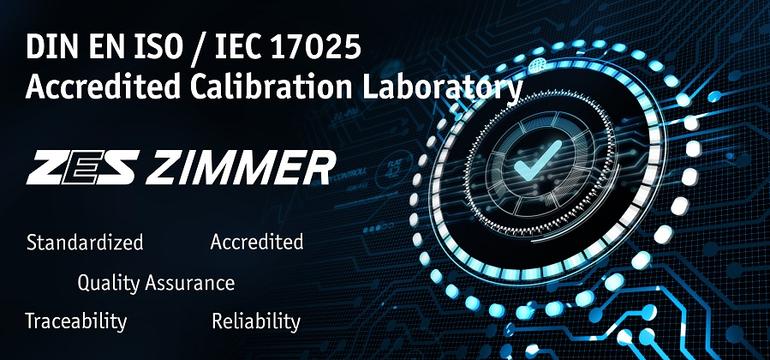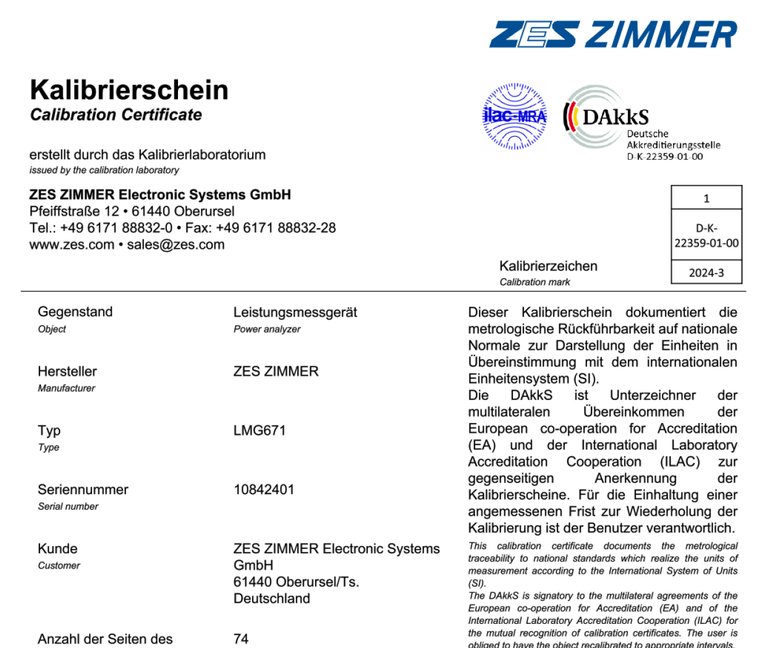Accredited Calibration Laboratory – Quality at ZES ZIMMER

Prior to delivery, our power measurement devices undergo an in-house, device-specific inspection. This process, following preliminary functional testing and adjustment, ensures compliance with each device's specifications. For each measuring device, we assess the conformity of the measured values with the corresponding manufacturer's specification. We offer equal service for the sensors in product portfolio.
With the calibration certificate, you are equipped to conduct measurements at any time that are traceable to national or international standards, thereby meeting the highest metrological demands for traceability.
To maintain this high level of quality, we recommend regular calibration of your ZES ZIMMER measuring devices at our facility, which includes complimentary maintenance. Any potential issues can be identified and resolved directly with minimal effort.
Users of our measuring devices, who are certified or seeking certification under industry-specific guidelines or quality assurance standards such as DIN ISO 9001, are required to implement and maintain calibration and monitoring of their testing equipment. In this regard, we offer you both a factory calibration in the non-accredited scope and a calibration in the DIN EN ISO/IEC 17025 accredited scope of the calibration laboratory.
Our Calibration Expertise – Your Added Value
The measurements we determine are traceable to national or international standards (typically to standards of the National Metrology Institute - Physikalisch-Technische Bundesanstalt (PTB) in our case). Our calibration laboratory has competent staff. Our successful accreditation according to DIN EN ISO/IEC 17025 is a testament to this.
Your key benefits:
- Expertise: Our specially trained professionals have an in-depth knowledge of our devices and possess the expertise to perform highly-quality calibrations.
- Time Efficiency: Services such as desired adjustments can be performed alongside calibration directly at our facility. This eliminates additional transport routes and times, expediting the process and minimizing downtime.
- Process Reliability: Our highly automated calibration and adjustment systems ensure the highest level of error resistance to the human factor.
- Cost Efficiency: We offer you a comprehensive service including complimentary maintenance all from a single source, saving you additional costs incurred by external service providers.
- Accredited Calibration Laboratory: Our laboratory, accredited by the German Accreditation Body (DAkkS) according to DIN EN ISO/IEC 17025, ensures the highest and most reliable quality standards.
Calibration According to DIN EN ISO/IEC 17025
Conformance to standards, quality assurance, and international comparability are increasingly crucial. Our in-house calibration laboratory, which operates at the highest quality standards, is accredited by the German Accreditation Body (DAkkS) according to the DIN EN ISO/IEC 17025 standard. The accreditation only applies to the scope of accreditation listed in the annex of the accreditation certificate D-K-22359-01-00, including, among others, alternating current, alternating voltage, and electrical power. We offer you a corresponding calibration of our power analyzers. Our laboratory's accreditation reflects our unwavering commitment to quality and our ongoing dedication to providing you with power measurement technology of highest standards and trustworthy measurement results. In this respect, our quality management plays a pivotal role.
Certificate:
Our accreditation (PDF)
Scope:
Annex to the Accreditation Certificate D-K-22359-01-00 (PDF)

In summary, our calibration laboratory offers you within the DIN EN ISO/IEC 17025 accredited scope:
- Reliability: You can rely on the validity and comparability of the calibration results, as wells as the dedicatedly trained expertise of our professionals.
- Traceability: You benefit from certainty during audits and quality inspections, as all measurements are verifiably traceable metrologically.
- Quality Assurance: You gain and experience confidence in our quality through our uncompromising commitment to our quality policy, which is steadfastly upheld for our clients as well.
- International Recognition: The ILAC MRA (ILAC Mutual Recognition Arrangement) symbol indicates worldwide recognition of the German accreditation body (DAkkS).
For further information in a personal consultation or to arrange a calibration appointment, please contact our service team via our contact form or directly connect with the ZES ZIMMER representative for your region here.
